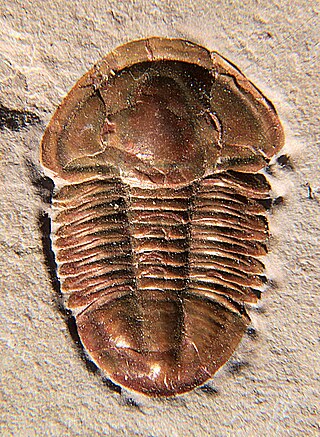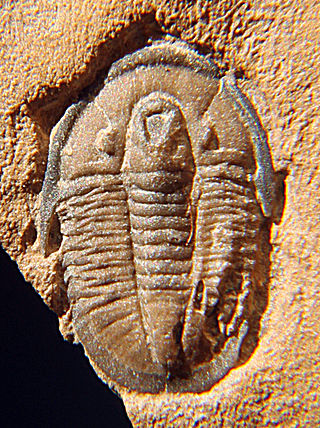Related Research Articles
The Treatise on Invertebrate Paleontology published by the Geological Society of America and the University of Kansas Press, is a definitive multi-authored work of some 50 volumes, written by more than 300 paleontologists, and covering every phylum, class, order, family, and genus of fossil and extant invertebrate animals. The prehistoric invertebrates are described as to their taxonomy, morphology, paleoecology, stratigraphic and paleogeographic range. However, taxa with no fossil record whatsoever have just a very brief listing.

Phacops is a genus of trilobites in the order Phacopida, family Phacopidae, that lived in Europe, northwestern Africa, North and South America and China from the Late Ordovician until the very end of the Devonian, with a broader time range described from the Late Ordovician. It was a rounded animal, with a globose head and large eyes, and probably fed on detritus. Phacops is often found rolled up ("volvation"), a biological defense mechanism that is widespread among smaller trilobites but further perfected in this genus.

Calymene Brongniart, 1822, is a genus of trilobites in the order Phacopida, suborder Calymenina, that are found throughout North America, North Africa, and Europe in primarily Silurian outcrops. Calymene is closely related to Flexicalymene, and both genera are frequently found enrolled. Calymene trilobites are small, typically 2 cm in length. The cephalon is the widest part of the animal and the thorax usually has 13 segments.
Eophacops is a genus of trilobites from the order Phacopida, family Phacopidae. These trilobites lived during the Middle Silurian in what now are North America and North-West Europe. Species assigned to this genus can be distinguished from Phacops by their small size (2–3 cm). Eophacops has very large eyes compared to the rest of its body.

Olenoides was a trilobite from the Cambrian period. Its fossils are found well-preserved in the Burgess Shale in Canada. It grew up to 10 cm long.

Asaphus is a genus of trilobites that is known from the Lower and Middle Ordovician of northwestern Europe.
Crepicephalus is an extinct genus from a well-known class of fossil marine arthropods, the trilobites. It lived from 501 to 490 million years ago during the Dresbachian faunal stage of the late Cambrian Period.

Asaphiscus is a genus of trilobite that lived in the Cambrian. Its remains have been found in Australia and North America, especially in Utah.
Dienstina is a trilobite in the order Phacopida, that existed during the lower Devonian in what is now Germany. It was described by Richter and Richter in 1931, and the type species is Dienstina diensti, which the authors had originally assigned to the genus Phacopidella in 1923. The type locality was in Oberscheld, Rhenish Massif.
Battus is a synonym for several agnostid trilobites, now assigned to other genera.
Carolinites is a genus of trilobite, assigned to the Telephinidae family, that occurs during the Lower and Middle Ordovician. Carolinites had a pantropical distribution, and there is evidence that it lived in upper parts of the water column. The free cheeks of Carolinites are largely covered by its huge eyes, except for the attachment of large genal spines that extend downward, backward and lateral and gradually curving further backward. The glabella is slightly bulbous, the occipital ring is well defined, but further transglabellar furrows are lacking. The thorax has 10 segments. The axis of the pygidium is highly vaulted, with a curved spine emerging almost perpendicular to the midline and ending parallel to it and a node on each of the other three segments. Carolinites is known from what are today Australia (Tasmania), Canada (Alberta), China, France, Spitsbergen, and the United States (Utah).
Entomostracites is a scientific name for several trilobites, now assigned to various other genera.
Westergaardites is an Upper Cambrian trilobite that is known from the Eastern Tian Shan. It is related to Triarthrus, but can easily be distinguished from it by an extremely long exoskeleton, anteriorly placed eyes, a thorax of 19 segments with an extremely wide axis, and very narrow pleural regions, pleural spines, and a pygidium with marginal spines.
Entomolithus is an obsolete scientific name for several trilobites, first published by Linnaeus in 1753, before the starting point of zoological nomenclature in a list under the heading "Paradoxus: 3. Entomolithus Monoculi". This is why this first name has no formal status. After the starting point of the zoological nomenclature, the name was published again in 1759, but with a different description. Because scholars incorrectly considered EntomolithusLinnaeus, 1759 a junior homonym, it was later replaced by EntomostracitesWahlenberg, 1818. Although the name as published in 1759 was in fact valid, the International Commission on Zoological Nomenclature decided to suppress EntomolithusLinnaeus, 1759, because this name had gone out of use for a very long time.
ConocephalitesBarrande, 1852, is a disused name for a genus of trilobite, of which the species have now been reassigned to other genera. The name was introduced as a replacement for ConocephalusZenker, 1833, which was unavailable since Thunberg used it in 1815 for a genus of conehead bushcricket. Barrande however was unaware that Conocoryphe had already been proposed by Hawle and Corda in 1847.
Raymondinidae are the only family in the trilobite superfamily Raymondinacea, which lived during the Middle and Upper Cambrian.

Cedaria is an extinct genus of trilobites from the late Cambrian.
ArionellusBarrande, 1850, is a disused name for a genus of trilobite. The name Arionellus was a replacement for ArionidesBarrande, 1847, itself a replacement for ArionBarrande, 1846, which was preoccupied because Férussac had already used it in 1819 for a genus of slugs.

Placoparia is a genus of trilobites of average size that lived during the late Lower to the early Upper Ordovician on the paleocontinents Gondwana, Avalonia and Laurentia, now the Czech Republic, France, Germany, Morocco, Portugal, Spain and Wales. Its headshield is semi-circular to rectangular with rounded frontal corners. It lacks eyes, but eye ridges are present. The fact that the facial sutures are opisthoparian is an exception in the otherwise proparian Cheirurina. The thorax has 11 or 12 segments, with the axis slightly wider than the ribs to its sides. The tips of the pleurae are free, which resembles an old-fashion central heating radiator. The axis in the small tailshield consists of four rings and a minute endpiece. The four pleurae end in spatulate spines that fit to corresponding indentations in the cephalon.

Entomaspis is an extinct genus of harpetid trilobite from Upper Cambrian to Early Ordovician marine strata of the United States. Species are typified by their proportionally large, vaulted, croissant-shaped or bonnet-shaped cephalons that have the cheeks freed to become elongated, curved librigenial spines, and by their comparatively large, crescent-shaped eyes.
References
- ↑ Moore, R.C. (1959). Arthropoda I - Arthropoda General Features, Proarthropoda, Euarthropoda General Features, Trilobitomorpha. Treatise on Invertebrate Paleontology. Vol. Part O. Boulder, Colorado/Lawrence, Kansas: Geological Society of America/University of Kansas Press. pp. 1–560. ISBN 0-8137-3015-5.
- ↑ Whittington, H. B. et al. Part O, Treatise on Invertebrate Paleontology. Revised, Volume 1 – Trilobita – Introduction, Order Agnostida, Order Redlichiida. 1997
- ↑ Ramskjöld, L.; Werdelin, L. (1991). "The phylogeny and evolution of some phacopid trilobites". Cladistics. 7: 29–74. doi: 10.1111/j.1096-0031.1991.tb00021.x . S2CID 85076301.
- ↑ von Leonard, K.C.; Bronn, H.G. (1836). Neues Jahrbuch für Mineralogie, Geolognosie, Paläontologie und Petrefactenkunde. E. Schweizerbart.